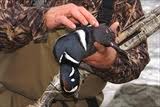
Preparation Makes Perfect
A great mount begins with the way you prepare your trophy in the field. A lot of trophies are ruined by sportsmen because they didn’t know how to care and prepare their trophy in the field. For example, we understand you want to show off your trophy, but don’t ride around with it in the back of your truck all day. Additionally, never, ever cut the throat of your deer if you want to mount it.
It’s also critical to get it skinned and frozen as soon as possible. When dragging your trophy, don’t let the head drag along the ground; rather, keep it off the ground as much as possible to prevent damaging the skin and hair. Remember, as soon as an animal dies it begins to decompose, and the longer it’s subject to the elements – especially heat – the greater the risk you could ruin your trophy
Shoulder Mounts
With your animal hanging as normal for field dressing, skin down to the front shoulders and avoid cutting in to the brisket and armpit area. Cut off the front legs at the knee, then carefully skin on down working out the front legs. Continue to skin on down the neck, but stop 4-6 inches from the skull as this is where you should cut the head off. Better still, leave as much of the hide attached and we will remove what’s not necessary. If you need to cut the excess off, remove it about middle ways of the body to ensure there is enough cape to work with. Then, place it in a plastic bag and freeze it until you can get it to us. If you can’t freeze it, keep it in a cooler on ice – but no more than one day.
Life Size Mounts
On most small life-size mounts – chipmunks to coyotes – you should freeze the entire animal by placing it in plastic bags. Leave it frozen until you drop it off at Otten Brothers Taxidermy. This process provides us with the ability to skin the animal a number ways depending on how you want it mounted. With larger life-size mounts, such as deer, antelope or bear, it’s best to bring it directly to Otten Brothers Taxidermy and we will skin it for you.
If you hunting for several days and unable bring your trophy directly to us, let us know before your hunt and we can instruct you exactly how to skin the animal based on the way you want to mount it. Most important, always freeze it as soon as possible.
Bird – Field Care
Bird Selection. – The best birds for taxidermy are generally your more mature, late season birds. All birds grow new plumage for the winter, not only to have good warmth, but, primarily, the males and females become more beautiful to find mates for spring. The later in the winter season, the better the possibility that the bird you have collected is in mint condition. Avoid birds with pin feathers. These feathers are common on waterfowl until mid-December and will fall out during the mounting process. When choosing between multiple birds of the same type, try and avoid birds with broken wings. Most importantly, avoid birds with broken feathers and/or feather loss.
Handle Carefully. — Try to avoid “wringing” the neck of a bird you intend to mount. The intense twisting of and subsequent breaking of the vertebra can cause damage to the skin and leave patches of feathers missing in the area the neck was twisted. Grasp the bird under the wings at the shoulder joints and compress the rib cage. This will crush the heart and kill the bird quickly. When carrying the bird, use the bill or the feet.
Freezing. — Freeze as soon as possible. Tuck the bird’s head under one wing or fold the wings in and lay the head over the back. Place the bird in a plastic bag and remove as much air as possible before sealing. If possible, mark the bag with the name and gender of the bird, the date shot and the location shot. If you are going to save it over a hunting season, write your hunting number on the bag. Freeze up to 2 years (you can keep them longer, just be sure they are in an air tight container or bag.
Field Care – Fish
If you prefer the traditional form of fish taxidermy proper field care is absolutely essential to obtain a high quality skin mount. These are the steps you need to take to ensure the best mount:
Handle Carefully.—The number one thing to remember is to keep the fish cold until it can be frozen. Also, if in a cooler or fish box, keep your fish on top of others. This will help to eliminate any blotchiness of the skin that may occur if other fish lay on top of it. Do not gut or otherwise cut or damage your fish. Do not place your fish in a plastic bag or wrap it in newspaper.
Freezing.—As soon as possible, after your fish is caught, double bag it in a trash bags or some type of plastic. Next, lay it as flat as you can in the freezer. The plastic will slow down freezer burn damage, and laying it flat will prevent damage to the fins and scale loss.
Take photos.— Always remember to photograph your fish! Photos should to be taken soon after your fish is caught, because color changes will occur quickly.
